 Baijnath is a small and delicate town situated on the banks of River Gomti. This beautiful spot lies in a flat valley called the Garur valley of Katyur and is surrounded by verdant rich green hills and beautiful terraced fields. In Kumaon region, Baijnath is amongst the famous place for its remote antiquity and historic importance.
Baijnath is a small and delicate town situated on the banks of River Gomti. This beautiful spot lies in a flat valley called the Garur valley of Katyur and is surrounded by verdant rich green hills and beautiful terraced fields. In Kumaon region, Baijnath is amongst the famous place for its remote antiquity and historic importance.
Location of Baijnath
Baijnath is located in the Uttarakhand state of India. It is situated at a distance of 19kms from Kausani and 26 kms from Bageshwar. Baijanth is 81 kms from the famous township Almora. It has an average elevation of 1,130 metres.
History of Baijnath
Baijnath was the capital of Katyuri Kings, who ruled the area from 7th-11th century AD. In the year 1901, it was a small village with a population of 148. Baijnath was once a capital of the Katyuri Dynasty, during their reign it came to be known as Kartikeyapura.
Heritage of Baijnath
Baijnath is renowned for its exquisitely carved and sculptured temples that were built by the Katyuri Kings that are some of the finest creations of the western Himalayas. The remains and ruins of the ancient glorious Katyuri kings lie at the banks of the Gomti River in the form of handful of temples. Among these, there is a temple, which is famous for its idol of Goddess Parvati, carved delicately out of black stone.
Beyond 8 kms further following the Gwaldam road, one approaches to the famous and well-known Kotkimai temple. One can also visit the famous Pandusthal that lies nearby, which is said to be the legendary battle ground of the Kauravas and Pandavas.
Mythological Story of Baijnath
The town derives its name from the ancient temple known as "Bajinath temple". It is believed that Lord Shiva and Parvati got married at the confluence of Rivers Garur and Gomti close to the temple. Thousands of tourists and devotees flock to the town during Mahashivratri to visit the temple dedicated to Lord Vaidyanatha.
Connectivity of Baijnath
Baijnath is well connected by air, rail and road. The nearest airport is at Pant Nagar (180 km from Kausani). The closest railway station is Kathgodam. Kausani is linked to Almora, Ranikhet, Pithoragarh and Nainital. It can be accessed by roads from Delhi, Chandigarh, Lucknow, Nainital, Pant Nagar and Ranikhet. September to May is the ideal time to visit the town.



















